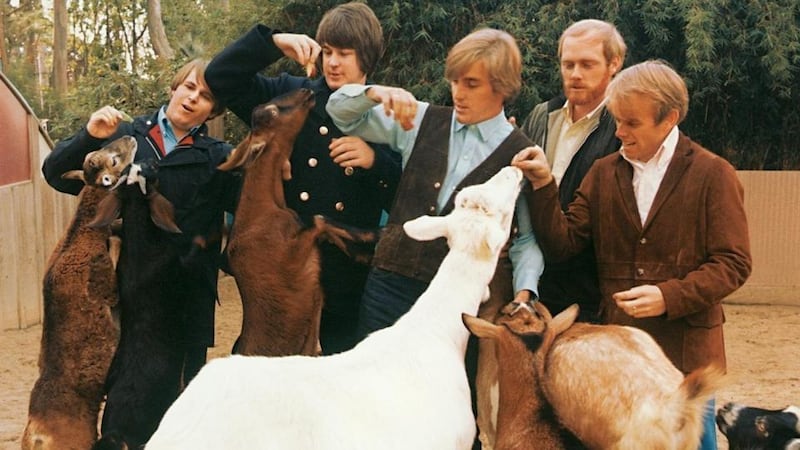They say that 1950 was the ideal year for music fans to be born. That’s because they would have been getting their teenage kicks at a time when The Beatles, Bob Dylan and The Beach Boys were hitting new heights and The Rolling Stones were coming up quickly on the inside. If rock music has an annus mirabilis it’s 1966. In one day alone, in May of that year, two of rock’s best albums were released: Dylan’s Blonde on Blonde and The Beach Boys’ Pet Sounds. A few months later The Beatles released Revolver, making the creative leap from She Loves You to Tomorrow Never Knows in three short years.
But even more than this happened in 1966: it was also the year of the first rock double album – Blonde on Blonde – the first boy-band album, the first concept album and, in The Byrds’ Fifth Dimension, the first psychedelic album. Throw in the facts that 1966 was also when an all-women act first reached number one on the Billboard album charts, when Neil Young made his recording debut, and when a young David Jones changed his surname to Bowie and the year becomes even more important.
Rock and pop had begun to make waves in the early years of the decade. But it wasn’t until 1966 that supposed novelty acts stopped writing simple love songs – The Beatles’ I Want to Hold Your Hand, say – and began making a real contribution to the canon.

The most ambitious leap was taken by Brian Wilson on May 16th, when Pet Sounds was released – to a dumbfounded response. The singalong surf’n’sun pocket symphonies that were The Beach Boys’ trademark had been replaced by songs of alienation. This wasn’t music to be sung along or danced to: this was music to sit down and listen to.
Pet Sounds’ release triggered one of music’s most magnificent duels. When Paul McCartney first heard the album he cried, realising that Wilson had just reset the bar for pop music, showing how complex but still lyrical it could be. The Beatles were to retaliate with Sgt Pepper’s Lonely Hearts Club Band the following year; according to George Martin, their producer, that album “was only ever an attempt to equal what Brian Wilson had achieved with Pet Sounds”.
It worked the other way around, too: Wilson wanted to keep track with The Beatles. But that quest led him to lose touch with reality during the recording of the aborted album Smile. You could argue that so closely did Wilson and The Beatles study each other’s work, and so strongly felt was the urge to outdo each other, that had Smile indeed come out in 1967 The Beatles might have taken a different path and avoided their dissolution as a partnership, in the high court in the 1970s.
In 1966 also, a heckler at Manchester Free Trade Hall shouted “Judas” at Bob Dylan for having the audacity to play an electric set . Dylan replied, “I don’t believe you . . . You’re a liar,” then told his band to “Play it f***in’ loud” as they launched into Like a Rolling Stone. That people felt betrayed by Dylan was a sign that the “folk poet” was, in tune with the experimental air of 1966, moving away from the musical ghetto that the decade’s early years had placed him in.
That The Supremes had a number-one album in the US August of 1966, with The Supremes A’ Go-Go, was significant because “girl groups” had previously been regarded as fit for releasing only singles. It would be a few years before Joni Mitchell, Carole King and other women made the real breakthrough, with self-composed albums, but The Supremes had taken a big step.
The boy band arrived in September of 1966, with The Monkees, four actors who had been assembled for a TV series, with little concern for their musical ability. They didn’t play on their first, self-titled album – that’s the famous Wrecking Crew session musicians you hear on the instruments – but they did at least provide the vocals. You might also say that the Monkees set the boy-band trajectory: early commercial success gives way to disillusion at being a packaged act and to a desire to have more authentic solo careers.
The concept album, for good or ill, emerged in October, with the release of The Kinks’ Face to Face. Written entirely by Ray Davies, the songs were supposed to be linked by pieces of music, so that the album would play without gaps, but the record company baulked at such radicalism. It’s not one of the band’s finest works, but it did have an impact.
Mr Rock Music
“There was definitely something in the air during 1966,” says Larry Gogan, the veteran DJ, who thinks of those 12 months as the “year of the album”. “I still remember hearing both Pet Sounds and Revolver for the first time and thinking that this really was something special.”
Gogan was Mr Rock Music that year. “There was just a lot of really great music released at the time: they used to joke at me that I would arrive in the studio at 9am on Monday morning and not leave until Saturday night at midnight, that’s how busy I was. I do remember The Kinks’s album being released – how different it was, and also how strange it must have been for them to be in an era at the same time as The Beatles and The Rolling Stones.
“The big one for me that year was Revolver. It was such a progression for the band. To this day the song that reminds me most of 1966 is Taxman, from that album. The groundwork was laid that year for all the stuff that followed, and in that sense it was a vitally important year, the most important ever,” Gogan says.
Johnnie Moylett, who went on to become Johnnie Fingers in The Boomtown Rats, was only 10 in 1966, but he says that, even so, the events of that year led him into a life of rock'n'roll. "I remember it as a time of freedom, of pirate radio stations off the coast, and you could pick up the groovy sounds on your transistor radio from Japan. London was swinging: the miniskirt arrived; Jean Shrimpton was the first female fashion icon. When she wore a miniskirt to the derby it was front-page news," Moylett says.
“My school friend Gerry Cott” – later also to become a Boomtown Rat – “bought Blonde on Blonde and I bought Revolver. We argued about which was the most important. In the end I bought Blonde on Blonde, too, just so we could remain friends.
In Glasthule, in south Dublin, the Caroline “beat club” opened. “Myself and Gerry Cott had passed by it when it was being built, and we asked if we could become members. On the spot we became junior members. My card number was 001, and Gerry’s was 002. I was into this new band from the North called Them. Their singer was Van Morrison, and he was very scary – he said ‘f***’, and we were shocked.”
Downward slide
But Eamon Carr, the writer, musician and founding member of Horslips, says we’ve got it wrong. “Nineteen sixty-six actually marked the beginning of a downward slide in a popular music culture that had promised so much the previous year,” he says.
What’s so special about 1965? Carr has it that, “for example, Dylan went electric and released a series of singles in ’65, including Subterranean Homesick Blues, Maggie’s Farm and Like a Rolling Stone, and also two thrilling albums, in Bringing It All Back Home and Highway 61 Revisited. I would take any of those 45rpms ahead of the droning Sad Eyed Lady of 1966. Also in ’65, the Stones brought us Satisfaction with added fuzz box, and Small Faces brought feedback on the superior Whatcha Going to Do About It.
“In 1965 The Beatles released Rubber Soul, which had mashed-up styles, extensive instrumentation and a sophistication previously not experienced by the public – and all without losing the spirit of pop.
This was the year, not 1966, that Motown artists were really on fire. Otis Redding released Otis Blue, on Stax Records, and that suggested a wonderful future. The Who’s My Generation galvanised their generation, and The Byrds’ Mr Tambourine Man pointed to viable new directions. I could go on.”
Carr argues that “in 1966 pop music fell into the hands of the squares”; possibly inspired by Brian Wilson, pop dullards became philosophers. The concept album destroyed rock’n’roll, he says, and led to deplorable excesses, not all of which were committed by The Who.
“Things got so bad that Dylan needed a motorbike crash to save himself, rescue his muse and salvage his integrity,” he says. “The real tragedy of The Beach Boys is that not even Charles Manson could put a stop to their infernal operatic harmonies.
“The thrilling future hinted at in 1965 was squandered by men possibly more suited to careers in a different artistic discipline. Rock music was snatched away from the delinquent and passionate by pop’s overeager head prefects. The music world never recovered from the witterings on Pet Sounds – presented by the most uncool band ever.”
Revisionism or reality check? Either way, Carr is bringing formidable insight to the table. We must now be due another year that, to paraphrase Mike Love of The Beach Boys, “f***s with the formula”. As The Beatles said, tomorrow never knows.


















